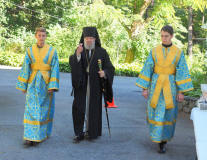
October 17, 2016
Mahopac, NY: Nativity of the Theotokos Celebrations held at New
Kursk Root Hermitage
 It
was a cool morning on Sunday, September 25, as clergy and
worshippers began to arrive at the New Kursk Root Hermitage from New
York, Connecticut, and New Jersey: on this day, the parish of the
Nativity of the Mother of God in Mahopac, NY traditionally holy
celebrations in honor of its patronal feast, which took place on
September 8/21.
It
was a cool morning on Sunday, September 25, as clergy and
worshippers began to arrive at the New Kursk Root Hermitage from New
York, Connecticut, and New Jersey: on this day, the parish of the
Nativity of the Mother of God in Mahopac, NY traditionally holy
celebrations in honor of its patronal feast, which took place on
September 8/21.
The festal peal of bells greeted His Grace, Bishop Jerome, who lives
and labors at the New Kursk Root Hermitage. He was accompanied by
Readers Vasily Shevelchinsky and John Temidis. Longtime parishioners
and parish treasurer Vyacheslav Maltsev greeted His Grace with bread
and salt. At Liturgy, Bishop Jerome was concelebrated by Archpriest
Nikolai Zhuravsky (cleric of the Georgian Orthodox Church and rector
of the Georgian parish recently established at the Hermitage),
Archpriest Ilya Gorsky (rector of Holy Virgin Protection Church in
Nyack, NY), Archpriest Alexander Donchenko (rector of St. Nicholas
Church in Poughkeepsie, NY), Abbot Cornelius (Apukhtin) and Priest
George Temidis (parish clerics), Protodeacon Dimitri Temidis (cleric
of Holy Protection Church in Nyack) and parish Deacon Alexey Pnev.
The parish of St. Nicholas Church in Poughkeepsie came to Mahopac,
in order to celebrate the feast together. The two parishes have
established a tradition of visiting for each other’s patronal
feasts.
 The
Liturgy was held in the parish church. The choir sang prayerfully
under the direction of longtime conductor Reader Maxim Needlman.
During the Cherubic Hymn, some of the worshippers began to sing with
the choir. The entire church sang the Creed triumphally, and "A
Mercy of Peace" was touchingly sung by both choir and worshippers
together. Among the large number of communicants were many children.
Owing to the large number of people present, the faithful were
communed from two chalices.
The
Liturgy was held in the parish church. The choir sang prayerfully
under the direction of longtime conductor Reader Maxim Needlman.
During the Cherubic Hymn, some of the worshippers began to sing with
the choir. The entire church sang the Creed triumphally, and "A
Mercy of Peace" was touchingly sung by both choir and worshippers
together. Among the large number of communicants were many children.
Owing to the large number of people present, the faithful were
communed from two chalices.
His Grace addressed the worshippers with two sermons: in Russian, on
the words of the Epistle reading, "Now He which establisheth us with
you in Christ, and hath anointed us, is God;" and in English, on the
words of the Gospel for the Sunday before the Exaltation of the
Cross: "For God so loved the world, that He gave His only-begotten
Son, that whosoever believeth in Him should not perish, but have
everlasting life."
A procession was held around the entire church. A congratulatory
note bearing well-wishing from Metropolitan Hilarion was read aloud,
which said, in part: "I rejoice alongside you in remembering the
great miracle of the uncovering of the Kursk Root Icon of the Mother
of God in 1295, on the very day of this Theotokion feast. The
original Kursk Icon of the Most Holy Virgin has been with us in the
Diaspora since 1920, and from the beginning of the 1950s, upon the
Icon’s arrival from Europe, our New Kursk Root Hermitage was founded
as her first home in America. During these festal days, just as in
the Synodal Cathedral, so also at the Hermitage, is the Mother of
God, our Protectress and Guide, especially glorified for her
intercession for us. Several days ago, the Kursk Root Icon departed
for its annual visitation to its homeland of Kursk, but its
wonderworking copy remains at the New Kursk Root Hermitage, serving
as a joy and comfort to all of the faithful."
After the Polychronion was intoned, over 200 people venerated the
cross.
A home-style luncheon, prepared through the efforts of the
sisterhood, parishioners, and guests, was a great success. People
sat and interacted in the parish hall, as well as outside in the
fresh air at well set tables. A panihida was served at the parish
cemetery. Some of the pilgrims ventured out to the pondside Chapel
of the Icon of the Mother of God "of the Passion," consecrated in
1964, which was newly restored after having been damaged by a
falling tree.
The church also held a booksale for old books in Russian and
English, all of the proceeds from which went to benefit the parish.
The celebrations at the New Kursk Root Hermitage were full of joy,
and those in attendance felt themselves at home.

Media Office of the Eastern American Diocese


